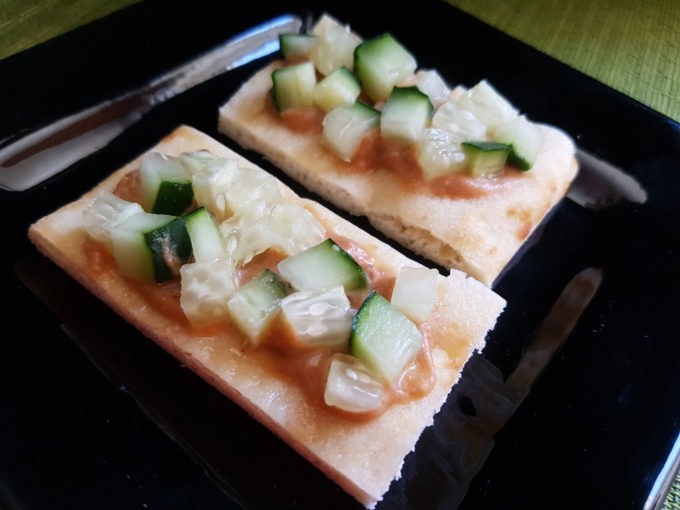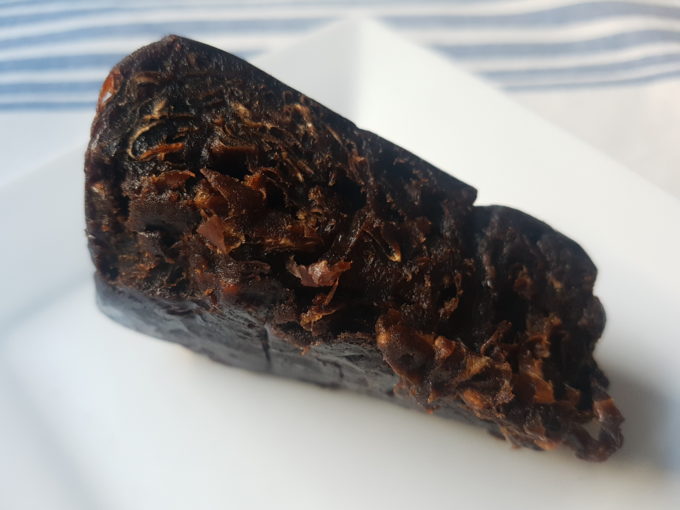
A two-bite appetizer: Tamarind and Lime Coconut Sauce served with cucumber and flat bread.

Tamarind and Lime Coconut Sauce tossed on thin rice noodles with sesame seeds.
I originally created this sauce for a green papaya salad, but soon discovered that it was great for a variety of uses. It’s particularly easy to toss on rice noodles, and it’s perfect to serve with mixed berries, but you can also use it to dress a cabbage slaw, or simply use it as a spread on a sandwich.
However you choose to use this dressing/sauce it has a wonderful, bright, freshness but also carries a substantial amount of body, making it very useful.

You have to trust me that this brown block of mush is so much more than just that! Wet Tamarind is a very versatile ingredient!
A word about tamarind:
I first found ‘wet tamarind’ in the little Asian market nearest my house. I was intrigued by it’s firm yet malleable texture. It was a few visits later before I finally decided to budget for it’s purchase… not that it’s expensive I just tend to want to buy everything new and interesting immediately and sometimes I just have to wait.
The first time I ever had tamarind was as a snack were the tamarind pulp and seeds had been coated in chili. Having no idea where the strange combination of flavors where coming from within the bite I was totally turned off, and confusingly associated tamarind with “spicy and gross” for a long time after that.
My next experience was as a mystery ingredient in our first Dueling Duleys Episode, in which Andrew picked out tamarind nectar for us to use. It was only then that my confusion was corrected. Tamarind is not spicy, nor is it gross.
Tamarind is both the name of a tree and the legume seed pods that it produces. When the outer casing is removed a sour tangy pulp is left around some rather large seeds. It grows in Mexico, as well as much of South Eastern Asia. India produces the vast majority of the world’s supply of tamarind. It can be purchased ‘wet’ such as I have done here, or dried as a powder. Be warned that the powder is supposed to be much more sour.
It is used all around the world for sauces, soups, and stews. A base for all kinds of dishes. It’s great in many of those prevalent Indian chutneys, common in deserts, and even in and as a beverage. I think that the average American has probably had the most common experience of finding tamarind as an exotic candy or snack item. I bet that with just a little bit of scouring and you will find tamarind being used in something you are already familiar with… even if you never knew it.

This special tool, used for mashing food for babies, is affectionately known as the Flamingo Foot.
As for working with it? I have read that you can soften wet tamarind paste by pushing it through a sieve, but I find it much easier to just add some warm water and mash it around. In fact I have a very special fork for just such a need. I created it for mashing food for babies but it was perfect for this job. Be sure to pull out any seeds you find, and you will probably want to remove the other husk-like chunks, although they can be eaten just fine. Perhaps softening a large batch to have on hand in the fridge for regular use would be the most productive process.
So if you have never used tamarind before I hope this easy and delicious sauce makes for a great jumping off place, and if you have other favorite uses for tamarind I would love for you to share them in the comments below!
Enjoy! And Tangy Salutations to you all!

Green papaya salad with crushed cashews, and a tamarind, lime and coconut sauce.
Tamarind and Lime, Coconut Dressing
By:semiserious chefs
Serves:
Ingredients:
- 1 T wet tamarind paste + 2 T hot water to soften*
- 1 T lime juice
- 1/4 t fish sauce (optional)**
- 2 T sugar
- 1 garlic clove, finely minced and crushed
- 1/4 cup coconut cream
- 1/4 t gochujang or red pepper flakes (more or less to taste)
- fresh Thai basil and/or mint to garnish, chopped
*To soften the tamarind paste I added some warm water and funky shaped fork that I use for mashing baby food. (See picture above.) You can also press it through a mesh sieve, but you will then need to add the water to your mix. The goal is to remove large pulp and any seeds.
**If you omit this, you will probably want to add a bit of salt.
Directions:
- Soften the tamarind into a bowl, using the hot water. Remove any seeds and casing pieces.
- Add the lime, fish sauce, sugar, mashed garlic, coconut cream, and gochujang. Mix thoroughly.
- Use to dress your desired dish and garnish with fresh chopped Thai basil and/or mint.


Post a comment